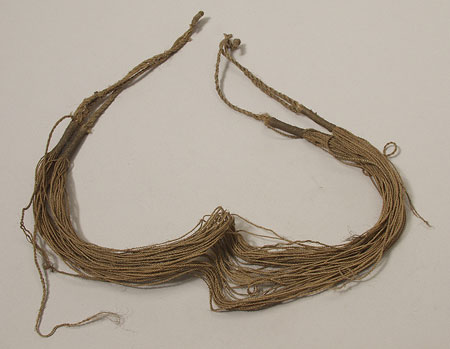Accession Number:
1934.8.63
Country:
Sudan
Region:
[Southern Sudan] Eastern Equatoria Navera
Cultural Group:
Lotuko [Otuho]
Date Made:
By 1933
Materials:
Plant Fibre , ?Grass Fibre Plant , String
Process:
Twisted , Bound , Knotted
Dimensions:
L = 965 mm, diam end cords = 3.5 mm; diam cylindrical binding = 6 mm, diam central strings = 1 mm [RTS 16/8/2004].
Weight:
24.5 g
Local Name:
nofi
Other Owners:
Collected by Percy Horace Gordon Powell-Cotton and his wife Hannah Powell-Cotton (nee Hannah Brayton Slater) at Navera on 6th April 1933 during a shooting expedition [RTS 16/8/2004].
Field Collector:
Percy Horace Gordon Powell-Cotton &
PRM Source:
Percy Horace Gordon Powell-Cotton
Acquired:
Donated 1934
Collected Date:
6th April 1933
Description:
Waist belt made from a series of twisted plant fibre strings, possibly grass.
This consists of a thick cord knotted at one end with a twisted 2 ply body; after 47 mm these split into two parts.
The upper part divides into 2 sections, each made of a length of 2 ply cord, which is joined after 145 mm to a group of 32 thin strings that make up the main body of the belt.
Each of these strings is composed of two fine strands of fibre twisted together.
The junction between the cord ties and string body is secured by a length of darker grey cord, bound several times around the join to make a tightly wound cylinder.
The pattern is repeated at the other end, with a cylindrical binding and two thicker lengths of cord beyond, that combine to form a single cord with a knot at the end.
The lower part is almost identical, except that the ends are made of one thick cord rather than two, and the main body is made of 34 fine strings rather than 32.
Finally, there appear to be a few loose lengths of cord tied into the cylindrical binding on both parts - these have fraying tapering ends, and it is not clear if they are separate pieces that played some part in fastening the belt around the waist, stray ends of other cords, or extra cords that once extended along the whole body but which have subsequently broken.
Otherwise, the object seems complete.
The cord and strings are a yellow colour (Pantone 7508C) while the binding is a more greyish brown (Pantone 7504C).
The belt has a weight of 24.5 grams, and is 965 mm long; the thick end cords have diameters of 3.5 mm, while the cylindrical bound areas have diameters of 6 mm and the central string work section consists of strings that measure only 1 mm across.
Collected by Percy Horace Gordon Powell-Cotton and his wife Hannah at Navera on 6th April 1933, during a shooting expedition. This type of object is known as nofi.
This object is currently on display in the Lower Gallery, case 118A.
Rachael Sparks 24/9/2005.
Collected by Percy Horace Gordon Powell-Cotton and his wife Hannah at Navera on 6th April 1933, during a shooting expedition. This type of object is known as nofi.
This object is currently on display in the Lower Gallery, case 118A.
Rachael Sparks 24/9/2005.
Primary Documentation:
Accession Book Entry
[p.
248] 1934 [insert] 8 [end insert] -
MAJOR P.
H.
G.
POWELL-COTTON
, Quex Park, Birchington, E.
Kent.
Specimens collected by himself & Mrs Cotton, during hunting trips, 1933, viz: [...] [p.
252] - From the
LATUKA
tribe, NAVERA, TORIT, LARONYO.
[p.
254, insert] 63 [end insert] - Waist-belt,
nofi
, of strings, ib[idem] [NAVERA] (445).
Card Catalogue Entry - There is no further information on the catalogue card [RTS 28/5/2004].
Related Documents File - Typewritten List of "Curios Presented to Dr. Balfour by Major & Mrs. Powell-Cotton. Tribe Latuka". This object appears as item 445: "Waist belt, fine fibre strings, native name Nofi , 6/4/33 Navera, about 4.30 N 32.30 E”. Also contains details of a cine film 'some tribes of the Southern Sudan', taken by Powell-Cotton during this 1933 expedition, copies of which are now in the National Film and Television Archive and the Powell-Cotton Museum in Kent [RTS 14/3/2005].
Pre-PRM label - D 445 [brown reused card tag, tied to object; RTS 16/8/2004].
Old Pitt Rivers Museum label - Nofi , waist-belt, LATUKA, NAVERA, E. SUDAN, 4° 30' N., 32° 30' E. d.d. Major Powell-Cotton, 1934 (445) [rectangular metal-edged tag, tied to object; RTS 16/8/2004].
Card Catalogue Entry - There is no further information on the catalogue card [RTS 28/5/2004].
Related Documents File - Typewritten List of "Curios Presented to Dr. Balfour by Major & Mrs. Powell-Cotton. Tribe Latuka". This object appears as item 445: "Waist belt, fine fibre strings, native name Nofi , 6/4/33 Navera, about 4.30 N 32.30 E”. Also contains details of a cine film 'some tribes of the Southern Sudan', taken by Powell-Cotton during this 1933 expedition, copies of which are now in the National Film and Television Archive and the Powell-Cotton Museum in Kent [RTS 14/3/2005].
Pre-PRM label - D 445 [brown reused card tag, tied to object; RTS 16/8/2004].
Old Pitt Rivers Museum label - Nofi , waist-belt, LATUKA, NAVERA, E. SUDAN, 4° 30' N., 32° 30' E. d.d. Major Powell-Cotton, 1934 (445) [rectangular metal-edged tag, tied to object; RTS 16/8/2004].




